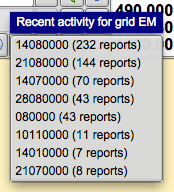Table of Contents
The PSK reporter can generate reception reports from three different sources:
- The decoded text, obtained from the Rx Panel text or the multi-channel browser. Note: the psk browser must be visible or decoding and subsequent psk reporting will not occur. If you do not want the psk browser panel visible in the main dialog then use the separate browser dialog. It can be minimized and signal decoding will continue.
- The log data
- Data entered manually
The configuration for the PSK reporter in in Misc/Spotting. PSKR needs the following fields from the Oper tab to be non-empty:
- Callsign (freeform because it's impossible to verify, and because we need to support SWLs without callsigns)
- Locator (standard 6 character format)
- Antenna info (freeform, should be kept reasonably short)
Sources (1) and (2) are configurable from Misc/Spotting configuration tab, while (3) is always enabled. To keep the code sane, changing the PSKR options (or the above station info) does not take immediate effect. Instead, the Initialize button changes color to indicate that the changes have not been applied. Clicking on the button will do so (or display an error) for the current and future sessions. This is similar to the Initialize buttons in the rig control configuration.
Here are the options in some more detail:
Automatically spot callsigns in decoded text
The text that is sent to the main window or the PSK browser is continuously searched for callsigns. If this option is enabled, the main window gets a "Spot" light button that can toggle the auto-spotter on and off. It is automatically turned off when playback is selected in the Files menu. The main window text is not searched if the viewer is active, i.e., if it is displayed and the current modem is PSK.
Send reception report when logging a QSO
A reception report is queued for every QSO as soon as it's logged
Report QRG (etc.)
This makes the reception reports include the current rig frequency, adjusted for modem audio frequency and rig sideband. It does not need a click on "Initialize" to take effect. This needs to be an option because it is impossible to tell whether the user has real or "fake" rig control with 100% certainty. Besides that, users may want to run a dedicated spotter for a narrow modes sub-band, and in that case they won't have to synchronise fldigi's frequency display with the rig all that often.
Host and port
With the port set to 14739 the reports will not be entered in the main database, but instead will be analysed and displayed here:
http://pskreporter.info/cgi-bin/psk-analysis.pl
Probably of no interest to anyone who is not hacking on a PSKR client but may be useful for debugging. The PSKR protocol uses UDP with no acknowledgements or retransmissions, so don't be surprised if the occasional report never makes it to the server. There should be enough coverage overlap to make packet loss irrelevant (and save a lot of bandwidth and CPU cycles).
The spotter needs to see a repeated callsign within a short search window, but stations do not always repeat their callsigns. In addition, some operators like to be creative with their macros, and as a result some signals will decode 100% but the callsign will never be auto-captured. Such callsigns can be reported manually.
The manual spotting is done by right-clicking the QRZ "globe" icon. This will generate a report for whatever is in the Call & Loc fields, so make sure that those are correct! You should also verify the frequency (e.g. by placing the waterfall marker on the signal being spotted).
There is a confirmation popup that will open when you right click the "globe" button. The aim of course is to avoid accidentally sending rubbish reports to the PSK reporter database.
Reception reports are filtered for duplicates among all data sources: a report is queued only once every hour for each callsign and frequency band. The queue is flushed every five minutes. You can see what the spotter is doing in the Event Log window or on the terminal if you set the log level to "Info". "Debug" will show all the gory details.

A button and popup text field on the rig control frame give access to the most recent receptions reports in your geographic area.The area is determined by the contents of the field to the right of the button, or by the locator text on the operator tab if the mini field is empty. The first two characters of the locator are used. If the locator is not set, the pskreporter.info uses the current IP geolocation to approximate it.
A popup is displayed when the user clicks the button or presses the Enter key from within the field. The popup shows the frequencies by measure of activity that gives more weight to transmissions. If rig control is active, the user can click on one of the lines to go to that band. Clicking on the 18100000 (1 report) line would immediately QSY the transceiver to 18.1 MHz.
The data is retrieved from http://pskreporter.info/cgi-bin/psk-freq.pl
or with a filled text field, http://pskreporter.info/cgi-bin/psk-freq.pl?grid=TEXT
There is a link to the pskreporter.info map page in the Help menu.